The Role of Clinical Audit: Enhancing Healthcare Quality and Outcomes
VerifiedAdded on 2023/06/09
|12
|3004
|274
Essay
AI Summary
This essay provides a detailed overview of clinical audits within the healthcare sector, defining it as a quality improvement process focused on enhancing healthcare delivery and patient outcomes through systematic reviews and comparisons against established standards. It examines the clinical audit process, which includes identifying problem areas, developing standards, collecting and evaluating data, implementing action plans, and re-evaluating improvements. The essay analyzes the impact of clinical audits on education and training by highlighting areas for improvement and professional development, as well as on clinical effectiveness by measuring the impact of interventions against evidence-based standards. Furthermore, it discusses the role of clinical audits in risk management by detecting errors and improving patient safety, and in research and development by promoting evidence-based practices and innovations. Finally, the essay outlines the benefits of clinical audits, such as improved patient care and reduced errors, while also addressing limitations like time constraints and funding challenges.
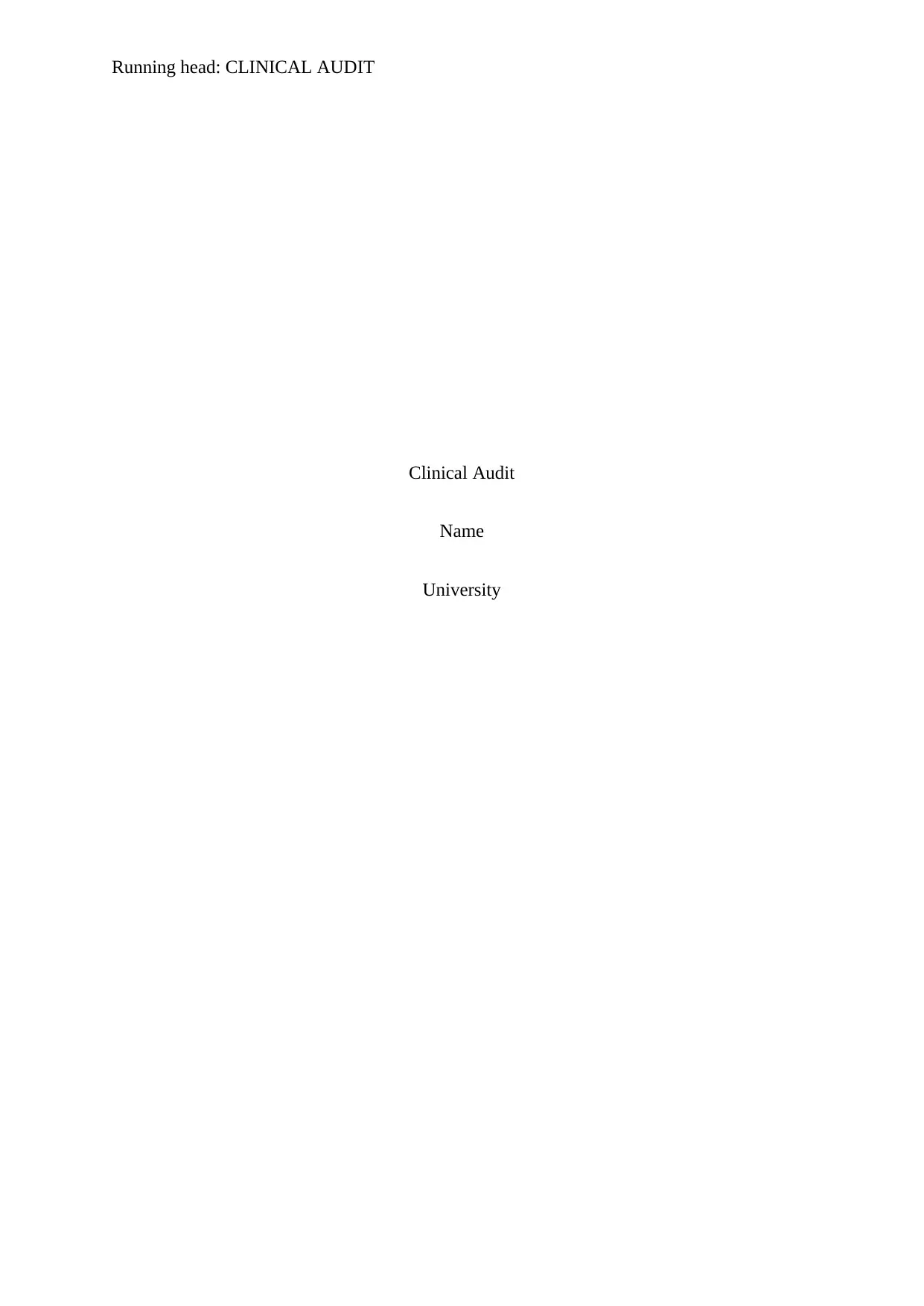
Running head: CLINICAL AUDIT
Clinical Audit
Name
University
Clinical Audit
Name
University
Paraphrase This Document
Need a fresh take? Get an instant paraphrase of this document with our AI Paraphraser
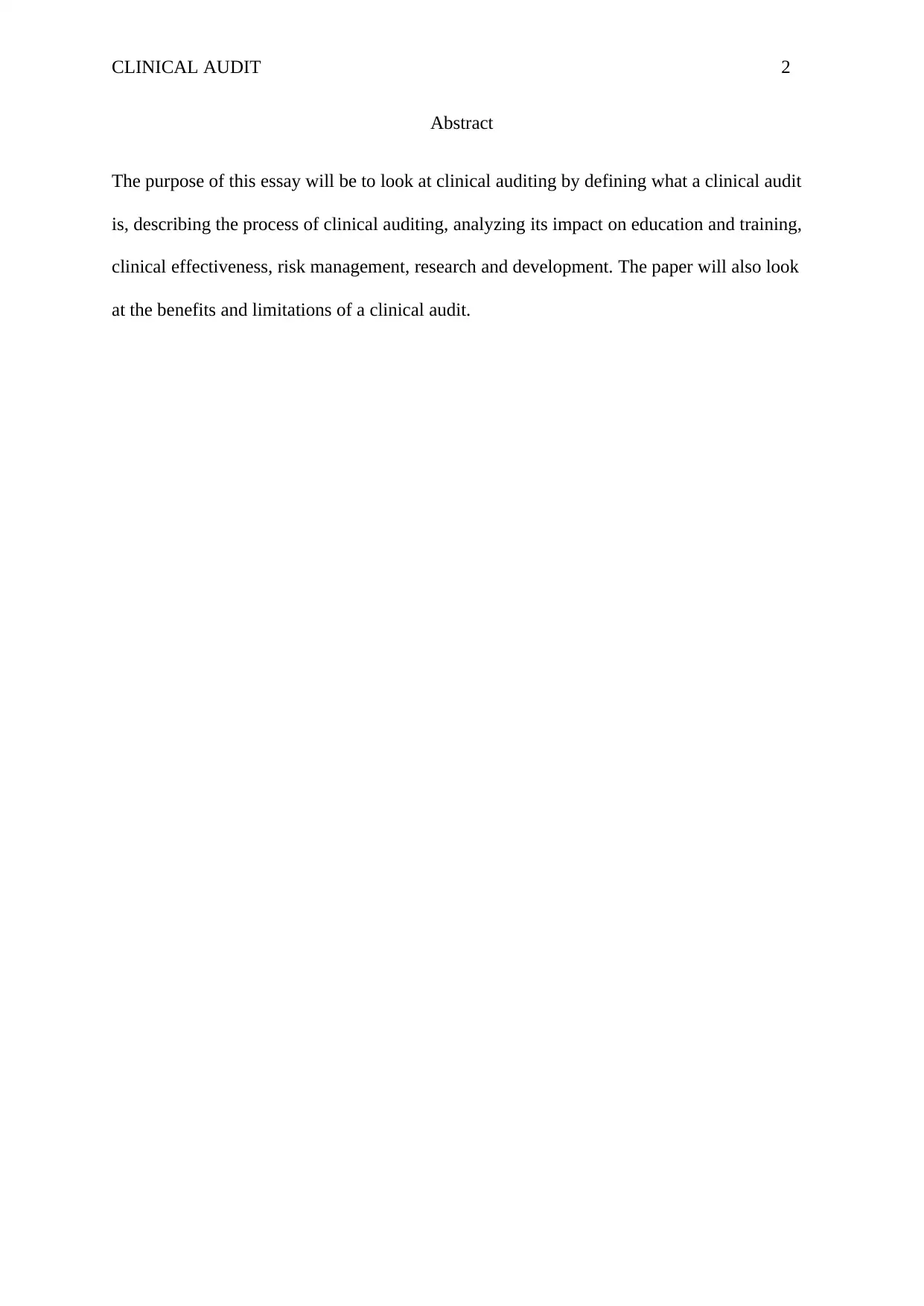
CLINICAL AUDIT 2
Abstract
The purpose of this essay will be to look at clinical auditing by defining what a clinical audit
is, describing the process of clinical auditing, analyzing its impact on education and training,
clinical effectiveness, risk management, research and development. The paper will also look
at the benefits and limitations of a clinical audit.
Abstract
The purpose of this essay will be to look at clinical auditing by defining what a clinical audit
is, describing the process of clinical auditing, analyzing its impact on education and training,
clinical effectiveness, risk management, research and development. The paper will also look
at the benefits and limitations of a clinical audit.
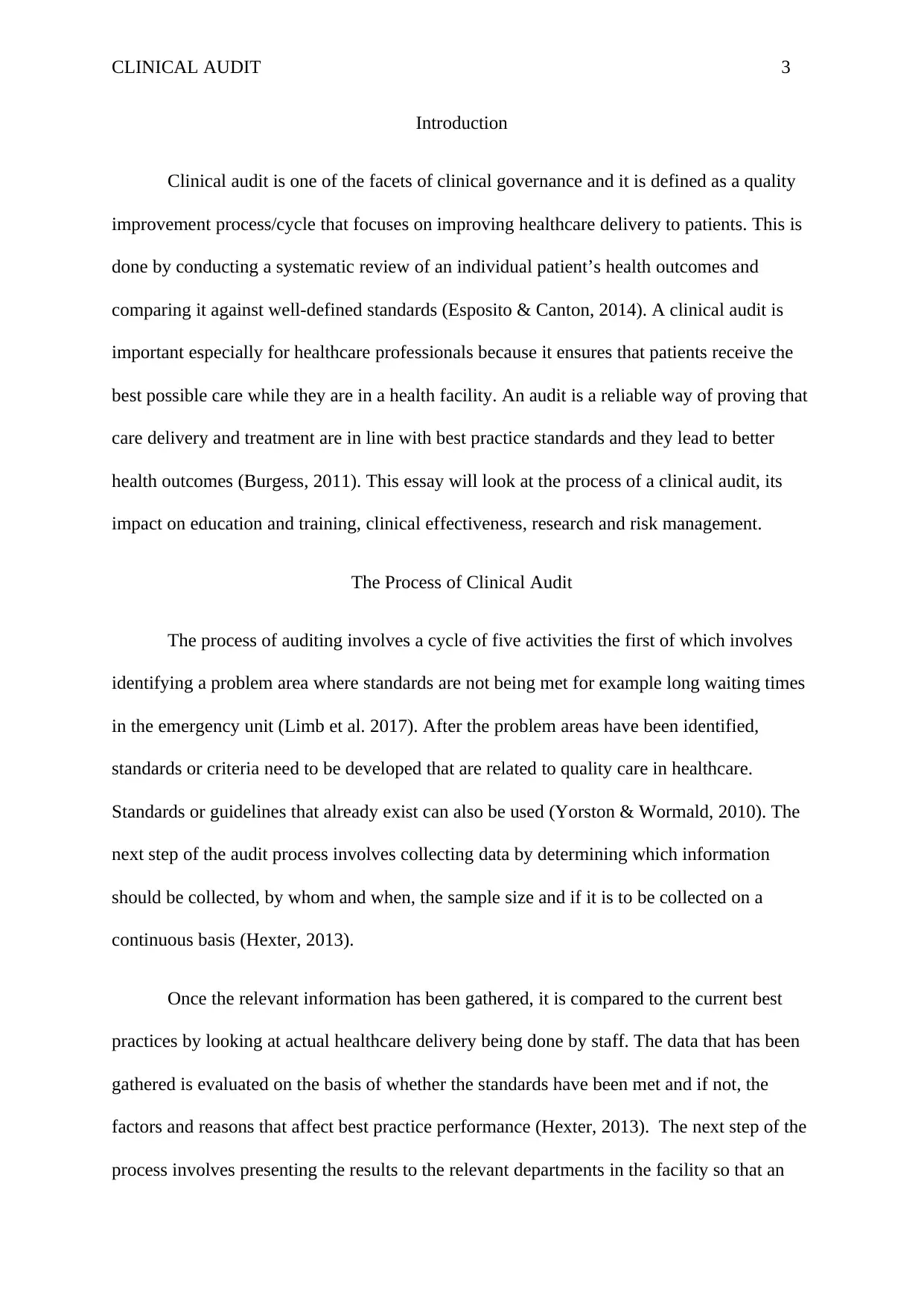
CLINICAL AUDIT 3
Introduction
Clinical audit is one of the facets of clinical governance and it is defined as a quality
improvement process/cycle that focuses on improving healthcare delivery to patients. This is
done by conducting a systematic review of an individual patient’s health outcomes and
comparing it against well-defined standards (Esposito & Canton, 2014). A clinical audit is
important especially for healthcare professionals because it ensures that patients receive the
best possible care while they are in a health facility. An audit is a reliable way of proving that
care delivery and treatment are in line with best practice standards and they lead to better
health outcomes (Burgess, 2011). This essay will look at the process of a clinical audit, its
impact on education and training, clinical effectiveness, research and risk management.
The Process of Clinical Audit
The process of auditing involves a cycle of five activities the first of which involves
identifying a problem area where standards are not being met for example long waiting times
in the emergency unit (Limb et al. 2017). After the problem areas have been identified,
standards or criteria need to be developed that are related to quality care in healthcare.
Standards or guidelines that already exist can also be used (Yorston & Wormald, 2010). The
next step of the audit process involves collecting data by determining which information
should be collected, by whom and when, the sample size and if it is to be collected on a
continuous basis (Hexter, 2013).
Once the relevant information has been gathered, it is compared to the current best
practices by looking at actual healthcare delivery being done by staff. The data that has been
gathered is evaluated on the basis of whether the standards have been met and if not, the
factors and reasons that affect best practice performance (Hexter, 2013). The next step of the
process involves presenting the results to the relevant departments in the facility so that an
Introduction
Clinical audit is one of the facets of clinical governance and it is defined as a quality
improvement process/cycle that focuses on improving healthcare delivery to patients. This is
done by conducting a systematic review of an individual patient’s health outcomes and
comparing it against well-defined standards (Esposito & Canton, 2014). A clinical audit is
important especially for healthcare professionals because it ensures that patients receive the
best possible care while they are in a health facility. An audit is a reliable way of proving that
care delivery and treatment are in line with best practice standards and they lead to better
health outcomes (Burgess, 2011). This essay will look at the process of a clinical audit, its
impact on education and training, clinical effectiveness, research and risk management.
The Process of Clinical Audit
The process of auditing involves a cycle of five activities the first of which involves
identifying a problem area where standards are not being met for example long waiting times
in the emergency unit (Limb et al. 2017). After the problem areas have been identified,
standards or criteria need to be developed that are related to quality care in healthcare.
Standards or guidelines that already exist can also be used (Yorston & Wormald, 2010). The
next step of the audit process involves collecting data by determining which information
should be collected, by whom and when, the sample size and if it is to be collected on a
continuous basis (Hexter, 2013).
Once the relevant information has been gathered, it is compared to the current best
practices by looking at actual healthcare delivery being done by staff. The data that has been
gathered is evaluated on the basis of whether the standards have been met and if not, the
factors and reasons that affect best practice performance (Hexter, 2013). The next step of the
process involves presenting the results to the relevant departments in the facility so that an
⊘ This is a preview!⊘
Do you want full access?
Subscribe today to unlock all pages.

Trusted by 1+ million students worldwide

CLINICAL AUDIT 4
action plan can be developed and implemented to improve on best practice. Evaluation needs
to be done after some time to assess if there are any improvements in care delivery. This is
done by gathering new information and comparing it against the set standards to determine if
there is an improvement (Benjamin, 2008).
Impact on Education and Training
Education and training refers to professional development and education where all
healthcare providers are required to engage in continuing education activities to ensure that
best practice is being performed (Starey, 2018). Continuing education is important because
what was learnt during nursing or medical school becomes outdated very quickly because of
new evidence-based research. It therefore becomes important to update ones professional
education to ensure that the best available healthcare is being given to health consumers
(Starey, 2018).
A clinical audit reviews the performance of healthcare personnel as they perform their
duties in a healthcare setting. The results of the audit are meant to improve the delivery
system and practice against the already set performance standards (Starey, 2018). In an audit
feedback process, the performance of individual members of a team are analyzed and
measured against their professional standards and current best practices. The results of the
audit are usually communicated back to the individual so that they can see which areas need
improvement and whether further education is needed to meet best practice standards (Ivers
et al., 2012. p.2).
Clinical audit impacts education and training because it identifies areas of
improvement in the performance of an individual during care delivery. It also provides a
method of reflecting on one’s performance while they are performing care based on the set
out standards. In the United Kingdom, doctors who are in training usually undergo at least
action plan can be developed and implemented to improve on best practice. Evaluation needs
to be done after some time to assess if there are any improvements in care delivery. This is
done by gathering new information and comparing it against the set standards to determine if
there is an improvement (Benjamin, 2008).
Impact on Education and Training
Education and training refers to professional development and education where all
healthcare providers are required to engage in continuing education activities to ensure that
best practice is being performed (Starey, 2018). Continuing education is important because
what was learnt during nursing or medical school becomes outdated very quickly because of
new evidence-based research. It therefore becomes important to update ones professional
education to ensure that the best available healthcare is being given to health consumers
(Starey, 2018).
A clinical audit reviews the performance of healthcare personnel as they perform their
duties in a healthcare setting. The results of the audit are meant to improve the delivery
system and practice against the already set performance standards (Starey, 2018). In an audit
feedback process, the performance of individual members of a team are analyzed and
measured against their professional standards and current best practices. The results of the
audit are usually communicated back to the individual so that they can see which areas need
improvement and whether further education is needed to meet best practice standards (Ivers
et al., 2012. p.2).
Clinical audit impacts education and training because it identifies areas of
improvement in the performance of an individual during care delivery. It also provides a
method of reflecting on one’s performance while they are performing care based on the set
out standards. In the United Kingdom, doctors who are in training usually undergo at least
Paraphrase This Document
Need a fresh take? Get an instant paraphrase of this document with our AI Paraphraser
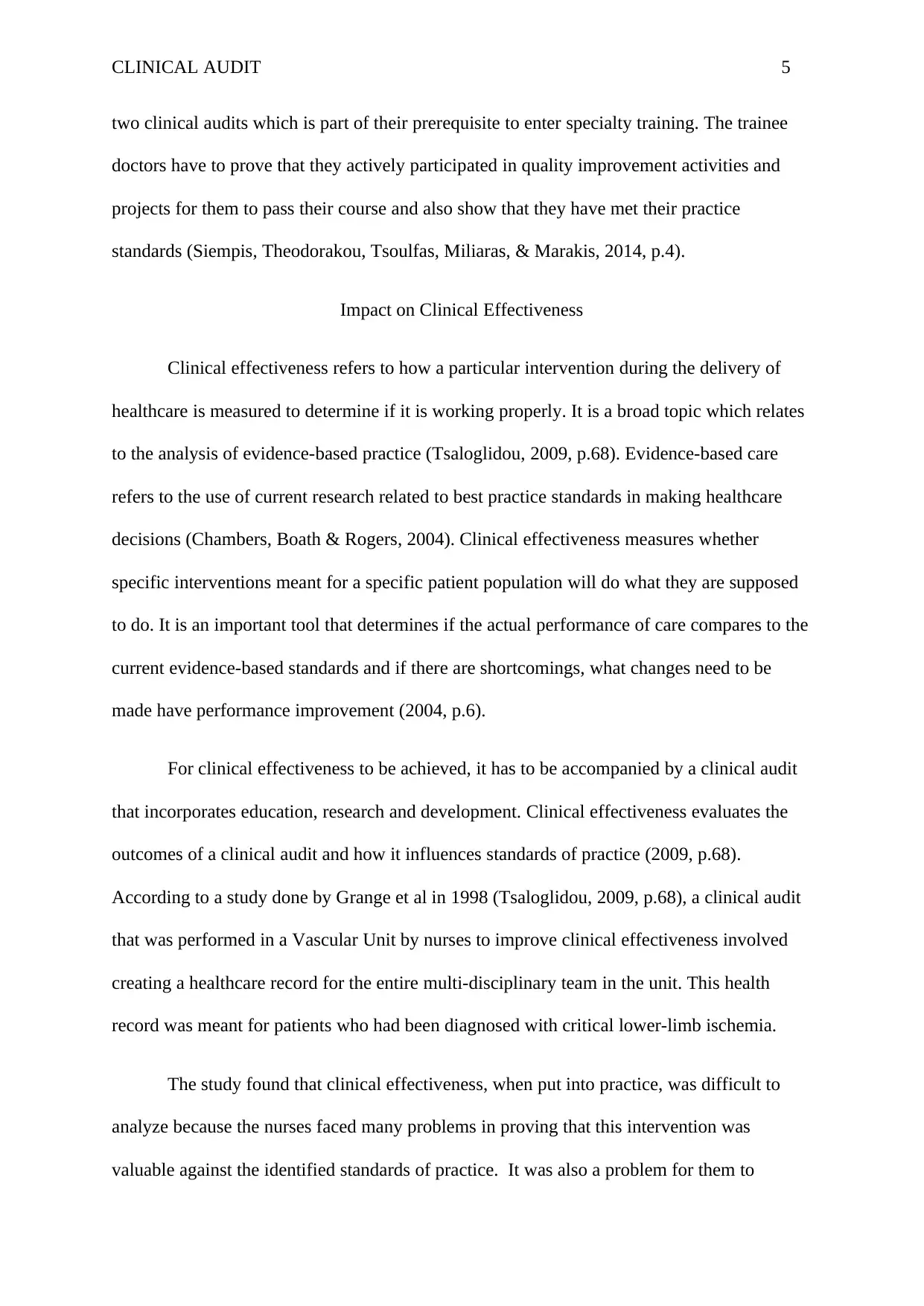
CLINICAL AUDIT 5
two clinical audits which is part of their prerequisite to enter specialty training. The trainee
doctors have to prove that they actively participated in quality improvement activities and
projects for them to pass their course and also show that they have met their practice
standards (Siempis, Theodorakou, Tsoulfas, Miliaras, & Marakis, 2014, p.4).
Impact on Clinical Effectiveness
Clinical effectiveness refers to how a particular intervention during the delivery of
healthcare is measured to determine if it is working properly. It is a broad topic which relates
to the analysis of evidence-based practice (Tsaloglidou, 2009, p.68). Evidence-based care
refers to the use of current research related to best practice standards in making healthcare
decisions (Chambers, Boath & Rogers, 2004). Clinical effectiveness measures whether
specific interventions meant for a specific patient population will do what they are supposed
to do. It is an important tool that determines if the actual performance of care compares to the
current evidence-based standards and if there are shortcomings, what changes need to be
made have performance improvement (2004, p.6).
For clinical effectiveness to be achieved, it has to be accompanied by a clinical audit
that incorporates education, research and development. Clinical effectiveness evaluates the
outcomes of a clinical audit and how it influences standards of practice (2009, p.68).
According to a study done by Grange et al in 1998 (Tsaloglidou, 2009, p.68), a clinical audit
that was performed in a Vascular Unit by nurses to improve clinical effectiveness involved
creating a healthcare record for the entire multi-disciplinary team in the unit. This health
record was meant for patients who had been diagnosed with critical lower-limb ischemia.
The study found that clinical effectiveness, when put into practice, was difficult to
analyze because the nurses faced many problems in proving that this intervention was
valuable against the identified standards of practice. It was also a problem for them to
two clinical audits which is part of their prerequisite to enter specialty training. The trainee
doctors have to prove that they actively participated in quality improvement activities and
projects for them to pass their course and also show that they have met their practice
standards (Siempis, Theodorakou, Tsoulfas, Miliaras, & Marakis, 2014, p.4).
Impact on Clinical Effectiveness
Clinical effectiveness refers to how a particular intervention during the delivery of
healthcare is measured to determine if it is working properly. It is a broad topic which relates
to the analysis of evidence-based practice (Tsaloglidou, 2009, p.68). Evidence-based care
refers to the use of current research related to best practice standards in making healthcare
decisions (Chambers, Boath & Rogers, 2004). Clinical effectiveness measures whether
specific interventions meant for a specific patient population will do what they are supposed
to do. It is an important tool that determines if the actual performance of care compares to the
current evidence-based standards and if there are shortcomings, what changes need to be
made have performance improvement (2004, p.6).
For clinical effectiveness to be achieved, it has to be accompanied by a clinical audit
that incorporates education, research and development. Clinical effectiveness evaluates the
outcomes of a clinical audit and how it influences standards of practice (2009, p.68).
According to a study done by Grange et al in 1998 (Tsaloglidou, 2009, p.68), a clinical audit
that was performed in a Vascular Unit by nurses to improve clinical effectiveness involved
creating a healthcare record for the entire multi-disciplinary team in the unit. This health
record was meant for patients who had been diagnosed with critical lower-limb ischemia.
The study found that clinical effectiveness, when put into practice, was difficult to
analyze because the nurses faced many problems in proving that this intervention was
valuable against the identified standards of practice. It was also a problem for them to
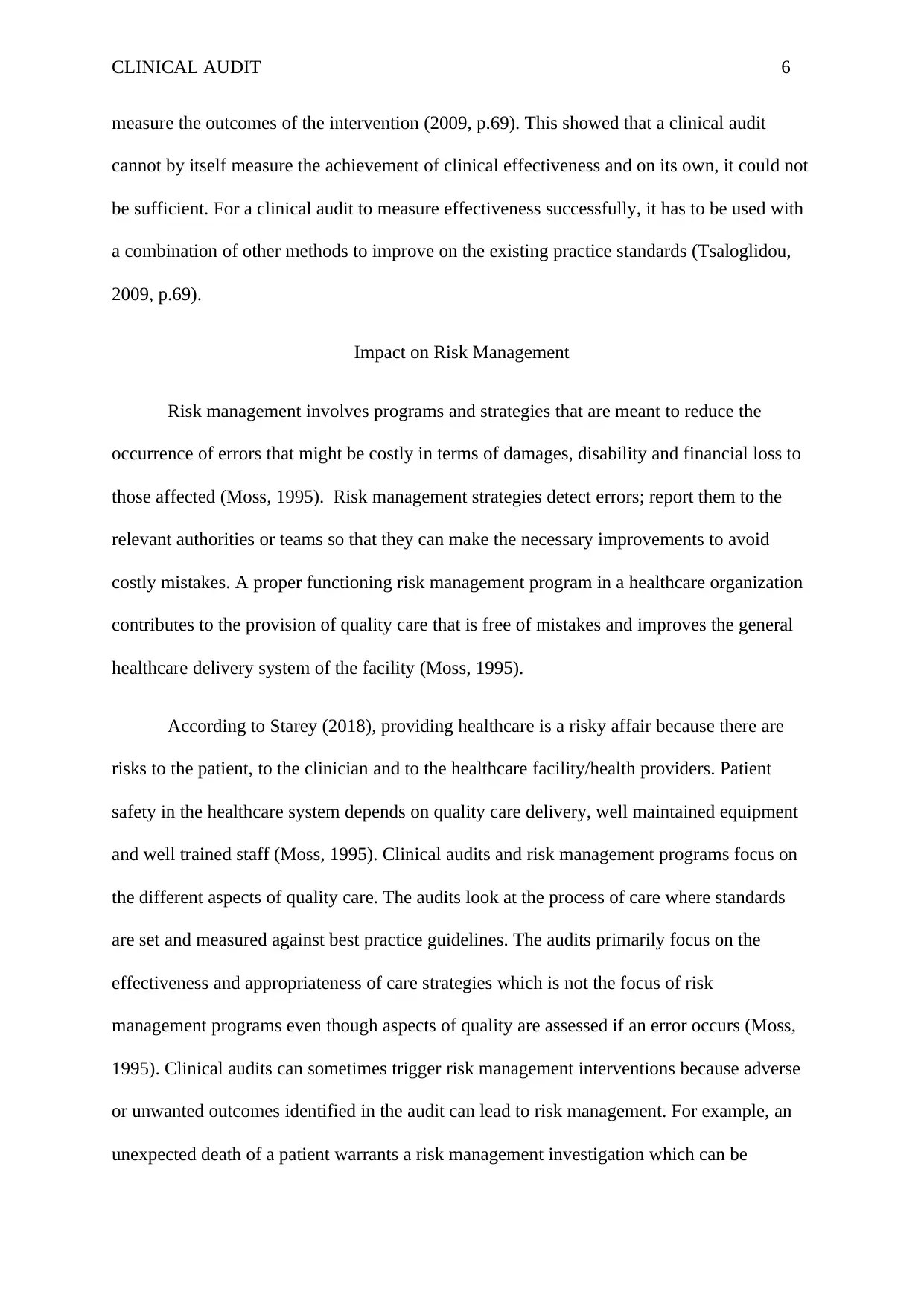
CLINICAL AUDIT 6
measure the outcomes of the intervention (2009, p.69). This showed that a clinical audit
cannot by itself measure the achievement of clinical effectiveness and on its own, it could not
be sufficient. For a clinical audit to measure effectiveness successfully, it has to be used with
a combination of other methods to improve on the existing practice standards (Tsaloglidou,
2009, p.69).
Impact on Risk Management
Risk management involves programs and strategies that are meant to reduce the
occurrence of errors that might be costly in terms of damages, disability and financial loss to
those affected (Moss, 1995). Risk management strategies detect errors; report them to the
relevant authorities or teams so that they can make the necessary improvements to avoid
costly mistakes. A proper functioning risk management program in a healthcare organization
contributes to the provision of quality care that is free of mistakes and improves the general
healthcare delivery system of the facility (Moss, 1995).
According to Starey (2018), providing healthcare is a risky affair because there are
risks to the patient, to the clinician and to the healthcare facility/health providers. Patient
safety in the healthcare system depends on quality care delivery, well maintained equipment
and well trained staff (Moss, 1995). Clinical audits and risk management programs focus on
the different aspects of quality care. The audits look at the process of care where standards
are set and measured against best practice guidelines. The audits primarily focus on the
effectiveness and appropriateness of care strategies which is not the focus of risk
management programs even though aspects of quality are assessed if an error occurs (Moss,
1995). Clinical audits can sometimes trigger risk management interventions because adverse
or unwanted outcomes identified in the audit can lead to risk management. For example, an
unexpected death of a patient warrants a risk management investigation which can be
measure the outcomes of the intervention (2009, p.69). This showed that a clinical audit
cannot by itself measure the achievement of clinical effectiveness and on its own, it could not
be sufficient. For a clinical audit to measure effectiveness successfully, it has to be used with
a combination of other methods to improve on the existing practice standards (Tsaloglidou,
2009, p.69).
Impact on Risk Management
Risk management involves programs and strategies that are meant to reduce the
occurrence of errors that might be costly in terms of damages, disability and financial loss to
those affected (Moss, 1995). Risk management strategies detect errors; report them to the
relevant authorities or teams so that they can make the necessary improvements to avoid
costly mistakes. A proper functioning risk management program in a healthcare organization
contributes to the provision of quality care that is free of mistakes and improves the general
healthcare delivery system of the facility (Moss, 1995).
According to Starey (2018), providing healthcare is a risky affair because there are
risks to the patient, to the clinician and to the healthcare facility/health providers. Patient
safety in the healthcare system depends on quality care delivery, well maintained equipment
and well trained staff (Moss, 1995). Clinical audits and risk management programs focus on
the different aspects of quality care. The audits look at the process of care where standards
are set and measured against best practice guidelines. The audits primarily focus on the
effectiveness and appropriateness of care strategies which is not the focus of risk
management programs even though aspects of quality are assessed if an error occurs (Moss,
1995). Clinical audits can sometimes trigger risk management interventions because adverse
or unwanted outcomes identified in the audit can lead to risk management. For example, an
unexpected death of a patient warrants a risk management investigation which can be
⊘ This is a preview!⊘
Do you want full access?
Subscribe today to unlock all pages.

Trusted by 1+ million students worldwide
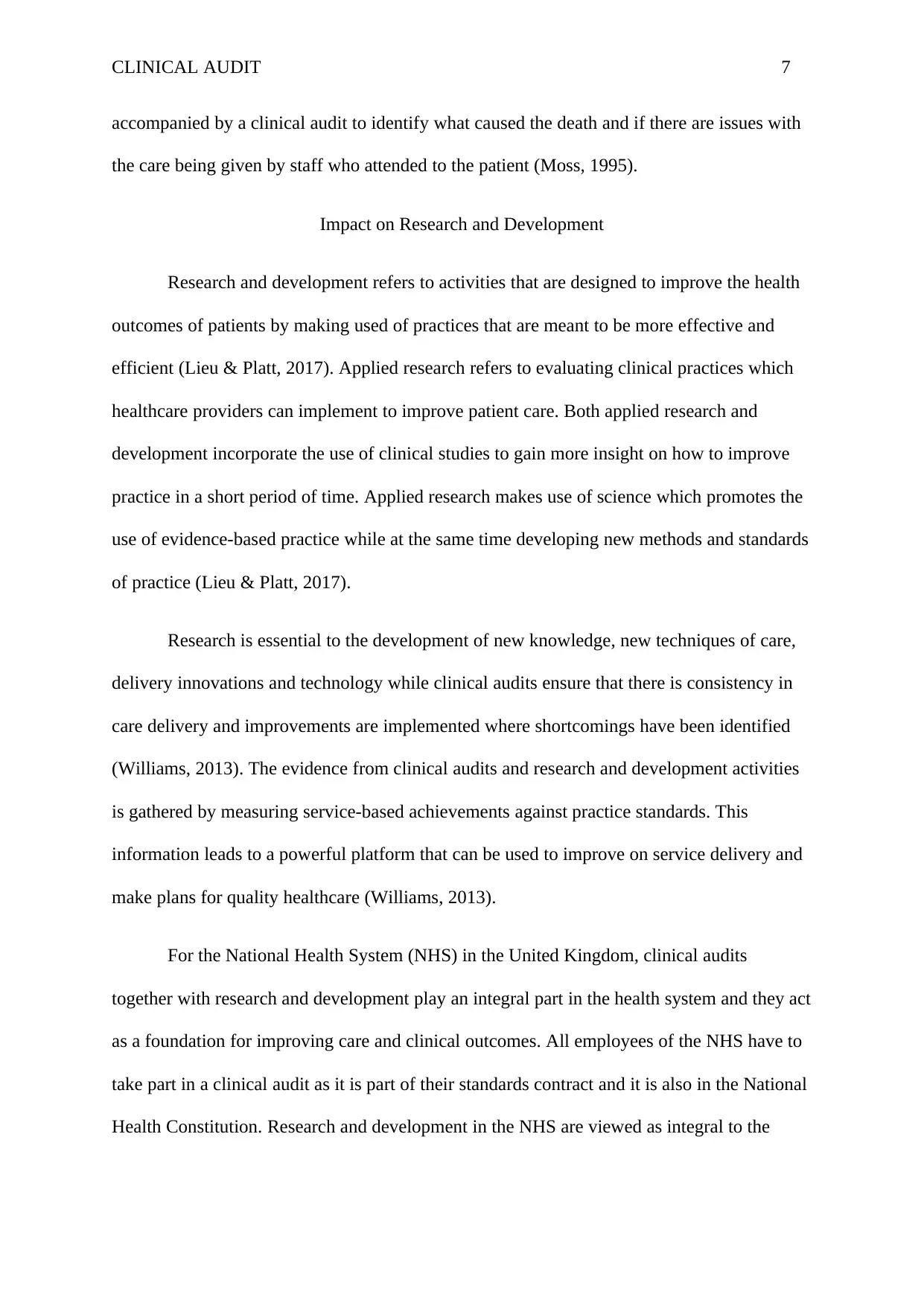
CLINICAL AUDIT 7
accompanied by a clinical audit to identify what caused the death and if there are issues with
the care being given by staff who attended to the patient (Moss, 1995).
Impact on Research and Development
Research and development refers to activities that are designed to improve the health
outcomes of patients by making used of practices that are meant to be more effective and
efficient (Lieu & Platt, 2017). Applied research refers to evaluating clinical practices which
healthcare providers can implement to improve patient care. Both applied research and
development incorporate the use of clinical studies to gain more insight on how to improve
practice in a short period of time. Applied research makes use of science which promotes the
use of evidence-based practice while at the same time developing new methods and standards
of practice (Lieu & Platt, 2017).
Research is essential to the development of new knowledge, new techniques of care,
delivery innovations and technology while clinical audits ensure that there is consistency in
care delivery and improvements are implemented where shortcomings have been identified
(Williams, 2013). The evidence from clinical audits and research and development activities
is gathered by measuring service-based achievements against practice standards. This
information leads to a powerful platform that can be used to improve on service delivery and
make plans for quality healthcare (Williams, 2013).
For the National Health System (NHS) in the United Kingdom, clinical audits
together with research and development play an integral part in the health system and they act
as a foundation for improving care and clinical outcomes. All employees of the NHS have to
take part in a clinical audit as it is part of their standards contract and it is also in the National
Health Constitution. Research and development in the NHS are viewed as integral to the
accompanied by a clinical audit to identify what caused the death and if there are issues with
the care being given by staff who attended to the patient (Moss, 1995).
Impact on Research and Development
Research and development refers to activities that are designed to improve the health
outcomes of patients by making used of practices that are meant to be more effective and
efficient (Lieu & Platt, 2017). Applied research refers to evaluating clinical practices which
healthcare providers can implement to improve patient care. Both applied research and
development incorporate the use of clinical studies to gain more insight on how to improve
practice in a short period of time. Applied research makes use of science which promotes the
use of evidence-based practice while at the same time developing new methods and standards
of practice (Lieu & Platt, 2017).
Research is essential to the development of new knowledge, new techniques of care,
delivery innovations and technology while clinical audits ensure that there is consistency in
care delivery and improvements are implemented where shortcomings have been identified
(Williams, 2013). The evidence from clinical audits and research and development activities
is gathered by measuring service-based achievements against practice standards. This
information leads to a powerful platform that can be used to improve on service delivery and
make plans for quality healthcare (Williams, 2013).
For the National Health System (NHS) in the United Kingdom, clinical audits
together with research and development play an integral part in the health system and they act
as a foundation for improving care and clinical outcomes. All employees of the NHS have to
take part in a clinical audit as it is part of their standards contract and it is also in the National
Health Constitution. Research and development in the NHS are viewed as integral to the
Paraphrase This Document
Need a fresh take? Get an instant paraphrase of this document with our AI Paraphraser
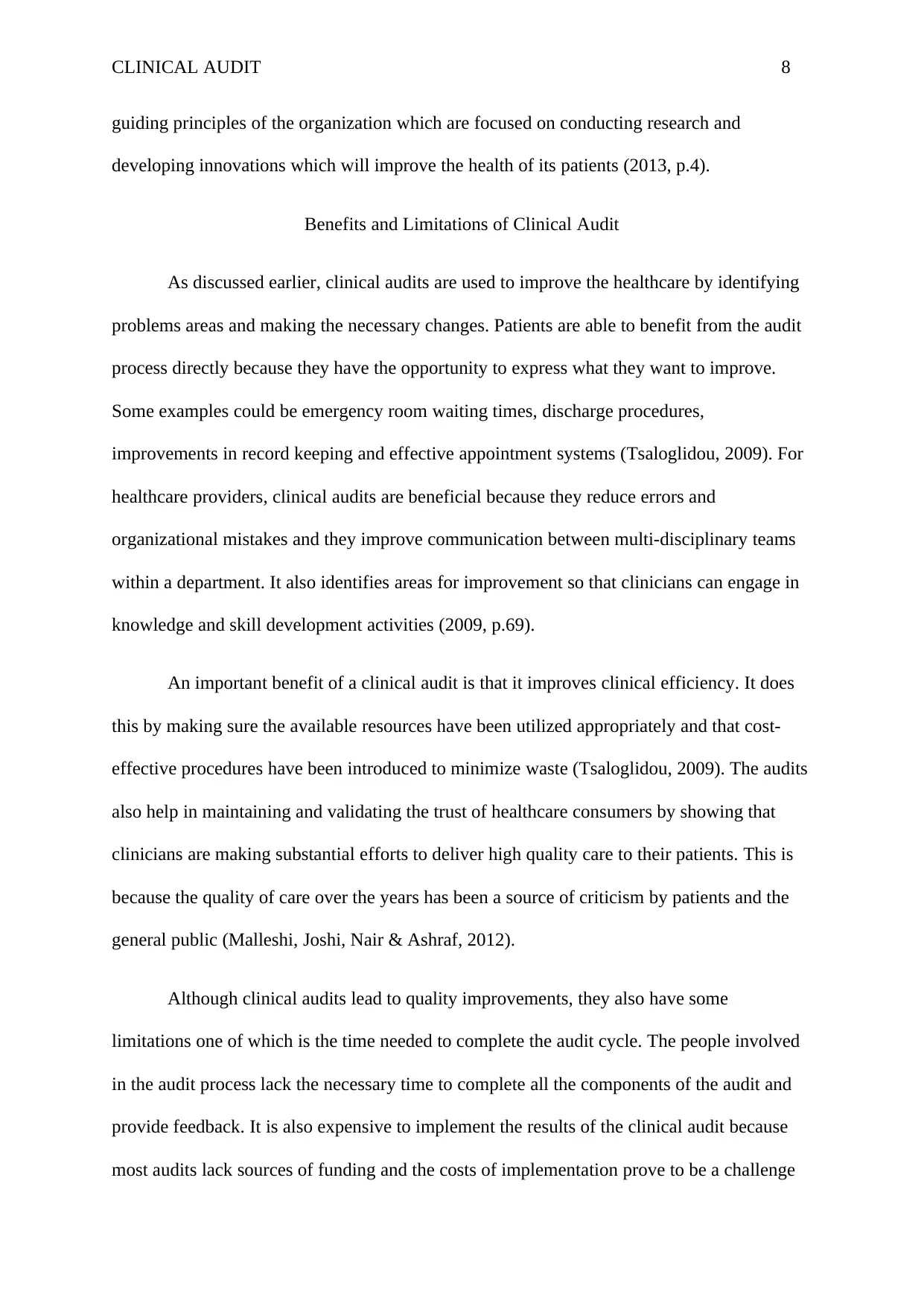
CLINICAL AUDIT 8
guiding principles of the organization which are focused on conducting research and
developing innovations which will improve the health of its patients (2013, p.4).
Benefits and Limitations of Clinical Audit
As discussed earlier, clinical audits are used to improve the healthcare by identifying
problems areas and making the necessary changes. Patients are able to benefit from the audit
process directly because they have the opportunity to express what they want to improve.
Some examples could be emergency room waiting times, discharge procedures,
improvements in record keeping and effective appointment systems (Tsaloglidou, 2009). For
healthcare providers, clinical audits are beneficial because they reduce errors and
organizational mistakes and they improve communication between multi-disciplinary teams
within a department. It also identifies areas for improvement so that clinicians can engage in
knowledge and skill development activities (2009, p.69).
An important benefit of a clinical audit is that it improves clinical efficiency. It does
this by making sure the available resources have been utilized appropriately and that cost-
effective procedures have been introduced to minimize waste (Tsaloglidou, 2009). The audits
also help in maintaining and validating the trust of healthcare consumers by showing that
clinicians are making substantial efforts to deliver high quality care to their patients. This is
because the quality of care over the years has been a source of criticism by patients and the
general public (Malleshi, Joshi, Nair & Ashraf, 2012).
Although clinical audits lead to quality improvements, they also have some
limitations one of which is the time needed to complete the audit cycle. The people involved
in the audit process lack the necessary time to complete all the components of the audit and
provide feedback. It is also expensive to implement the results of the clinical audit because
most audits lack sources of funding and the costs of implementation prove to be a challenge
guiding principles of the organization which are focused on conducting research and
developing innovations which will improve the health of its patients (2013, p.4).
Benefits and Limitations of Clinical Audit
As discussed earlier, clinical audits are used to improve the healthcare by identifying
problems areas and making the necessary changes. Patients are able to benefit from the audit
process directly because they have the opportunity to express what they want to improve.
Some examples could be emergency room waiting times, discharge procedures,
improvements in record keeping and effective appointment systems (Tsaloglidou, 2009). For
healthcare providers, clinical audits are beneficial because they reduce errors and
organizational mistakes and they improve communication between multi-disciplinary teams
within a department. It also identifies areas for improvement so that clinicians can engage in
knowledge and skill development activities (2009, p.69).
An important benefit of a clinical audit is that it improves clinical efficiency. It does
this by making sure the available resources have been utilized appropriately and that cost-
effective procedures have been introduced to minimize waste (Tsaloglidou, 2009). The audits
also help in maintaining and validating the trust of healthcare consumers by showing that
clinicians are making substantial efforts to deliver high quality care to their patients. This is
because the quality of care over the years has been a source of criticism by patients and the
general public (Malleshi, Joshi, Nair & Ashraf, 2012).
Although clinical audits lead to quality improvements, they also have some
limitations one of which is the time needed to complete the audit cycle. The people involved
in the audit process lack the necessary time to complete all the components of the audit and
provide feedback. It is also expensive to implement the results of the clinical audit because
most audits lack sources of funding and the costs of implementation prove to be a challenge
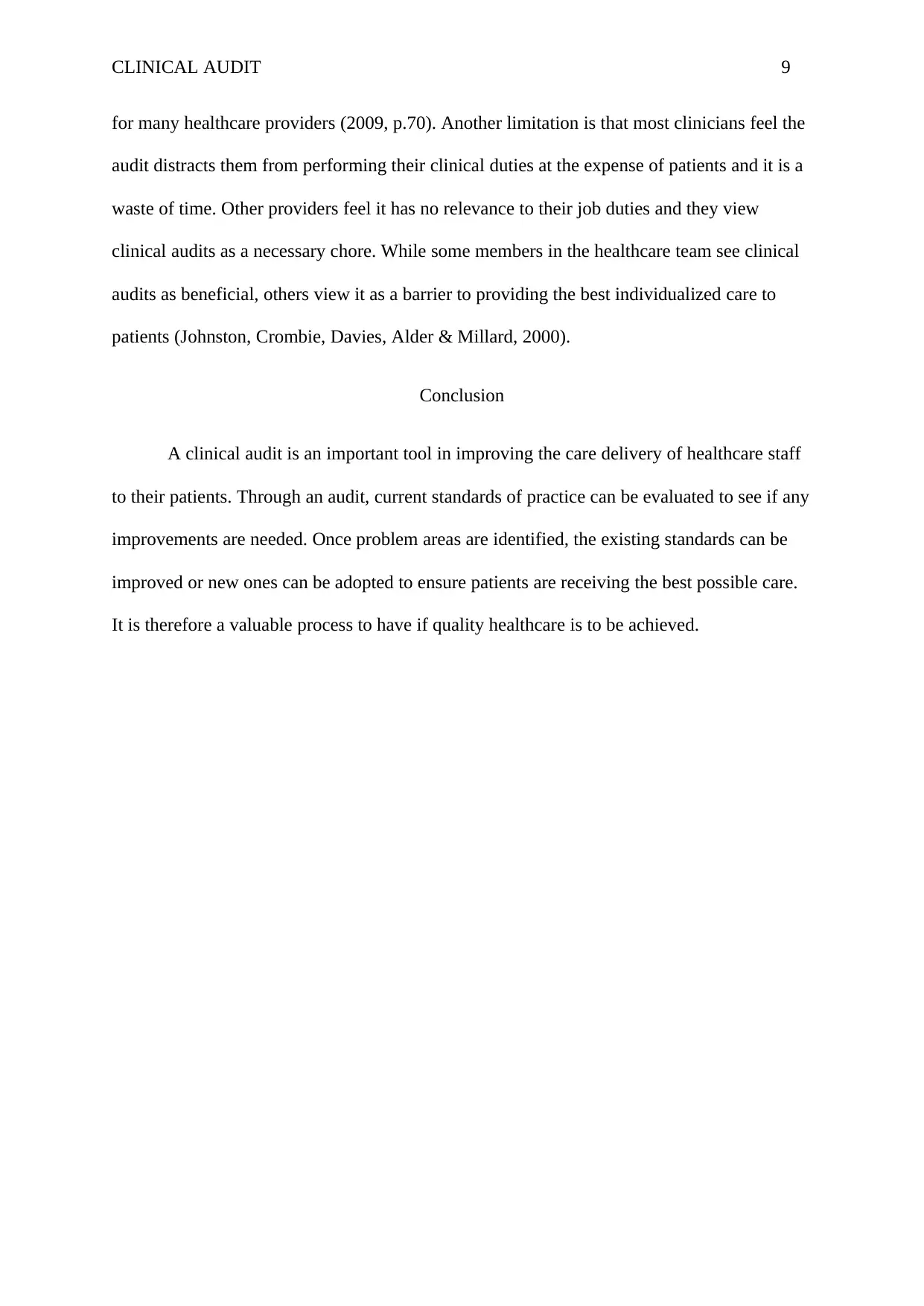
CLINICAL AUDIT 9
for many healthcare providers (2009, p.70). Another limitation is that most clinicians feel the
audit distracts them from performing their clinical duties at the expense of patients and it is a
waste of time. Other providers feel it has no relevance to their job duties and they view
clinical audits as a necessary chore. While some members in the healthcare team see clinical
audits as beneficial, others view it as a barrier to providing the best individualized care to
patients (Johnston, Crombie, Davies, Alder & Millard, 2000).
Conclusion
A clinical audit is an important tool in improving the care delivery of healthcare staff
to their patients. Through an audit, current standards of practice can be evaluated to see if any
improvements are needed. Once problem areas are identified, the existing standards can be
improved or new ones can be adopted to ensure patients are receiving the best possible care.
It is therefore a valuable process to have if quality healthcare is to be achieved.
for many healthcare providers (2009, p.70). Another limitation is that most clinicians feel the
audit distracts them from performing their clinical duties at the expense of patients and it is a
waste of time. Other providers feel it has no relevance to their job duties and they view
clinical audits as a necessary chore. While some members in the healthcare team see clinical
audits as beneficial, others view it as a barrier to providing the best individualized care to
patients (Johnston, Crombie, Davies, Alder & Millard, 2000).
Conclusion
A clinical audit is an important tool in improving the care delivery of healthcare staff
to their patients. Through an audit, current standards of practice can be evaluated to see if any
improvements are needed. Once problem areas are identified, the existing standards can be
improved or new ones can be adopted to ensure patients are receiving the best possible care.
It is therefore a valuable process to have if quality healthcare is to be achieved.
⊘ This is a preview!⊘
Do you want full access?
Subscribe today to unlock all pages.

Trusted by 1+ million students worldwide
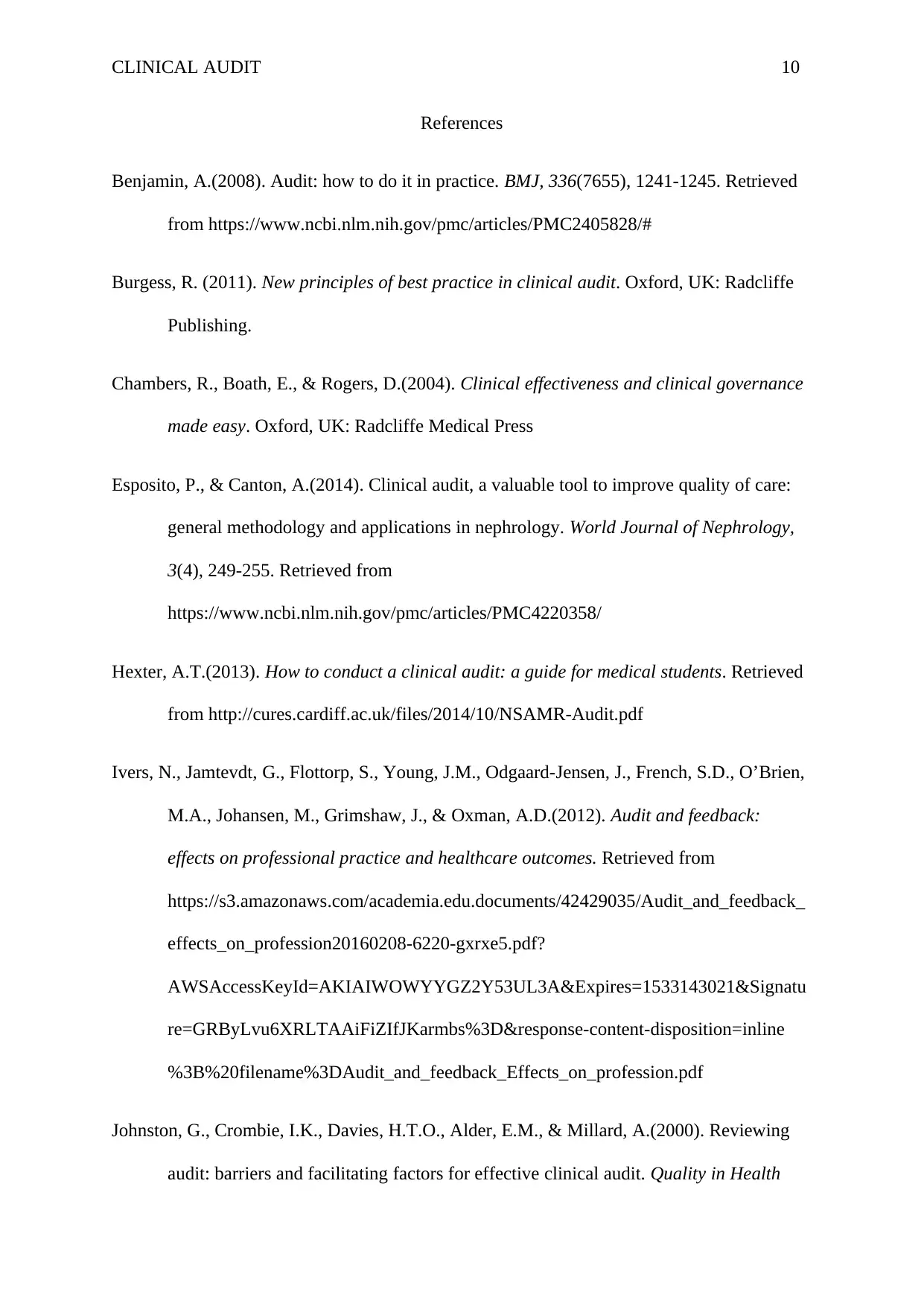
CLINICAL AUDIT 10
References
Benjamin, A.(2008). Audit: how to do it in practice. BMJ, 336(7655), 1241-1245. Retrieved
from https://www.ncbi.nlm.nih.gov/pmc/articles/PMC2405828/#
Burgess, R. (2011). New principles of best practice in clinical audit. Oxford, UK: Radcliffe
Publishing.
Chambers, R., Boath, E., & Rogers, D.(2004). Clinical effectiveness and clinical governance
made easy. Oxford, UK: Radcliffe Medical Press
Esposito, P., & Canton, A.(2014). Clinical audit, a valuable tool to improve quality of care:
general methodology and applications in nephrology. World Journal of Nephrology,
3(4), 249-255. Retrieved from
https://www.ncbi.nlm.nih.gov/pmc/articles/PMC4220358/
Hexter, A.T.(2013). How to conduct a clinical audit: a guide for medical students. Retrieved
from http://cures.cardiff.ac.uk/files/2014/10/NSAMR-Audit.pdf
Ivers, N., Jamtevdt, G., Flottorp, S., Young, J.M., Odgaard-Jensen, J., French, S.D., O’Brien,
M.A., Johansen, M., Grimshaw, J., & Oxman, A.D.(2012). Audit and feedback:
effects on professional practice and healthcare outcomes. Retrieved from
https://s3.amazonaws.com/academia.edu.documents/42429035/Audit_and_feedback_
effects_on_profession20160208-6220-gxrxe5.pdf?
AWSAccessKeyId=AKIAIWOWYYGZ2Y53UL3A&Expires=1533143021&Signatu
re=GRByLvu6XRLTAAiFiZIfJKarmbs%3D&response-content-disposition=inline
%3B%20filename%3DAudit_and_feedback_Effects_on_profession.pdf
Johnston, G., Crombie, I.K., Davies, H.T.O., Alder, E.M., & Millard, A.(2000). Reviewing
audit: barriers and facilitating factors for effective clinical audit. Quality in Health
References
Benjamin, A.(2008). Audit: how to do it in practice. BMJ, 336(7655), 1241-1245. Retrieved
from https://www.ncbi.nlm.nih.gov/pmc/articles/PMC2405828/#
Burgess, R. (2011). New principles of best practice in clinical audit. Oxford, UK: Radcliffe
Publishing.
Chambers, R., Boath, E., & Rogers, D.(2004). Clinical effectiveness and clinical governance
made easy. Oxford, UK: Radcliffe Medical Press
Esposito, P., & Canton, A.(2014). Clinical audit, a valuable tool to improve quality of care:
general methodology and applications in nephrology. World Journal of Nephrology,
3(4), 249-255. Retrieved from
https://www.ncbi.nlm.nih.gov/pmc/articles/PMC4220358/
Hexter, A.T.(2013). How to conduct a clinical audit: a guide for medical students. Retrieved
from http://cures.cardiff.ac.uk/files/2014/10/NSAMR-Audit.pdf
Ivers, N., Jamtevdt, G., Flottorp, S., Young, J.M., Odgaard-Jensen, J., French, S.D., O’Brien,
M.A., Johansen, M., Grimshaw, J., & Oxman, A.D.(2012). Audit and feedback:
effects on professional practice and healthcare outcomes. Retrieved from
https://s3.amazonaws.com/academia.edu.documents/42429035/Audit_and_feedback_
effects_on_profession20160208-6220-gxrxe5.pdf?
AWSAccessKeyId=AKIAIWOWYYGZ2Y53UL3A&Expires=1533143021&Signatu
re=GRByLvu6XRLTAAiFiZIfJKarmbs%3D&response-content-disposition=inline
%3B%20filename%3DAudit_and_feedback_Effects_on_profession.pdf
Johnston, G., Crombie, I.K., Davies, H.T.O., Alder, E.M., & Millard, A.(2000). Reviewing
audit: barriers and facilitating factors for effective clinical audit. Quality in Health
Paraphrase This Document
Need a fresh take? Get an instant paraphrase of this document with our AI Paraphraser
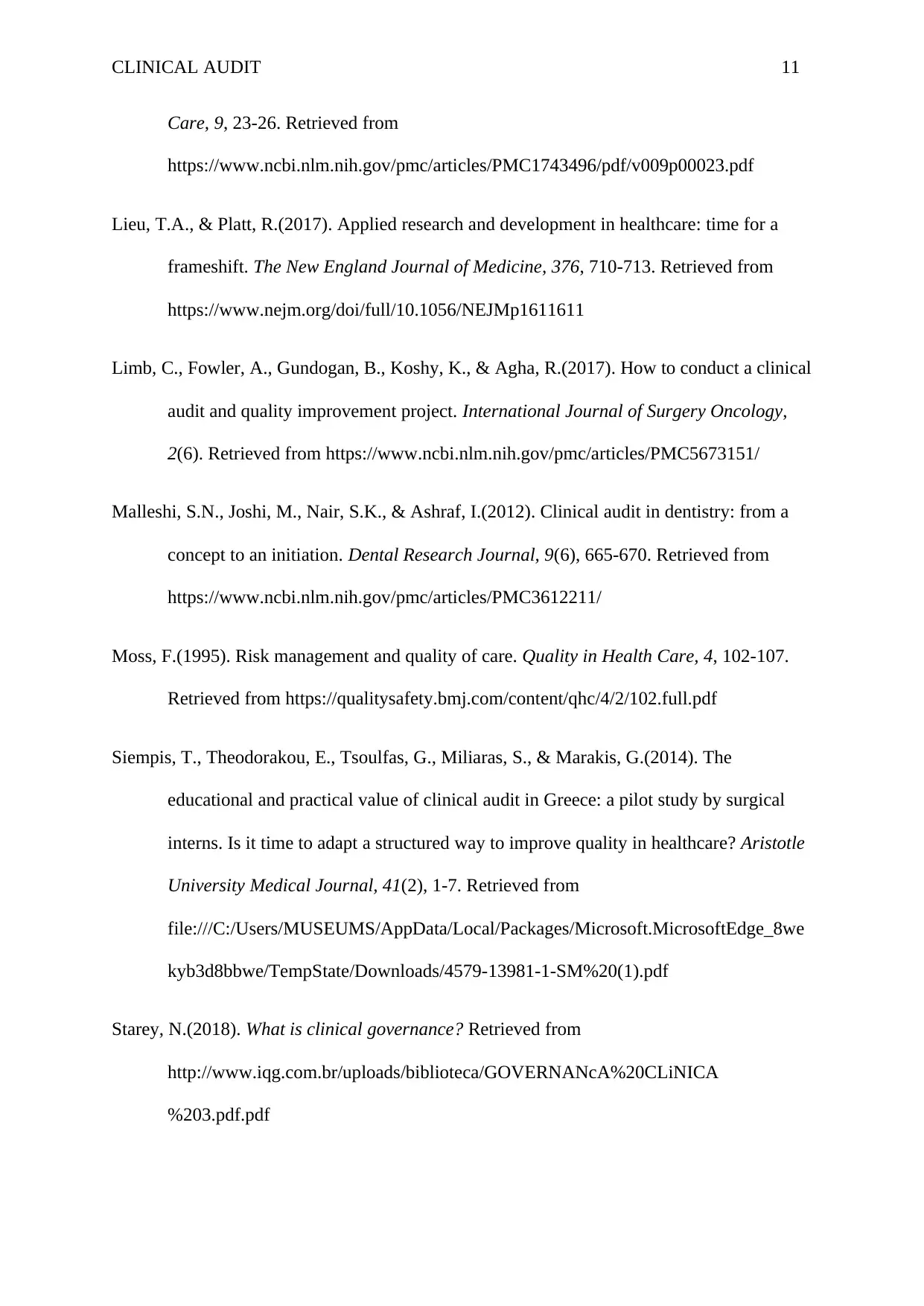
CLINICAL AUDIT 11
Care, 9, 23-26. Retrieved from
https://www.ncbi.nlm.nih.gov/pmc/articles/PMC1743496/pdf/v009p00023.pdf
Lieu, T.A., & Platt, R.(2017). Applied research and development in healthcare: time for a
frameshift. The New England Journal of Medicine, 376, 710-713. Retrieved from
https://www.nejm.org/doi/full/10.1056/NEJMp1611611
Limb, C., Fowler, A., Gundogan, B., Koshy, K., & Agha, R.(2017). How to conduct a clinical
audit and quality improvement project. International Journal of Surgery Oncology,
2(6). Retrieved from https://www.ncbi.nlm.nih.gov/pmc/articles/PMC5673151/
Malleshi, S.N., Joshi, M., Nair, S.K., & Ashraf, I.(2012). Clinical audit in dentistry: from a
concept to an initiation. Dental Research Journal, 9(6), 665-670. Retrieved from
https://www.ncbi.nlm.nih.gov/pmc/articles/PMC3612211/
Moss, F.(1995). Risk management and quality of care. Quality in Health Care, 4, 102-107.
Retrieved from https://qualitysafety.bmj.com/content/qhc/4/2/102.full.pdf
Siempis, T., Theodorakou, E., Tsoulfas, G., Miliaras, S., & Marakis, G.(2014). The
educational and practical value of clinical audit in Greece: a pilot study by surgical
interns. Is it time to adapt a structured way to improve quality in healthcare? Aristotle
University Medical Journal, 41(2), 1-7. Retrieved from
file:///C:/Users/MUSEUMS/AppData/Local/Packages/Microsoft.MicrosoftEdge_8we
kyb3d8bbwe/TempState/Downloads/4579-13981-1-SM%20(1).pdf
Starey, N.(2018). What is clinical governance? Retrieved from
http://www.iqg.com.br/uploads/biblioteca/GOVERNANcA%20CLiNICA
%203.pdf.pdf
Care, 9, 23-26. Retrieved from
https://www.ncbi.nlm.nih.gov/pmc/articles/PMC1743496/pdf/v009p00023.pdf
Lieu, T.A., & Platt, R.(2017). Applied research and development in healthcare: time for a
frameshift. The New England Journal of Medicine, 376, 710-713. Retrieved from
https://www.nejm.org/doi/full/10.1056/NEJMp1611611
Limb, C., Fowler, A., Gundogan, B., Koshy, K., & Agha, R.(2017). How to conduct a clinical
audit and quality improvement project. International Journal of Surgery Oncology,
2(6). Retrieved from https://www.ncbi.nlm.nih.gov/pmc/articles/PMC5673151/
Malleshi, S.N., Joshi, M., Nair, S.K., & Ashraf, I.(2012). Clinical audit in dentistry: from a
concept to an initiation. Dental Research Journal, 9(6), 665-670. Retrieved from
https://www.ncbi.nlm.nih.gov/pmc/articles/PMC3612211/
Moss, F.(1995). Risk management and quality of care. Quality in Health Care, 4, 102-107.
Retrieved from https://qualitysafety.bmj.com/content/qhc/4/2/102.full.pdf
Siempis, T., Theodorakou, E., Tsoulfas, G., Miliaras, S., & Marakis, G.(2014). The
educational and practical value of clinical audit in Greece: a pilot study by surgical
interns. Is it time to adapt a structured way to improve quality in healthcare? Aristotle
University Medical Journal, 41(2), 1-7. Retrieved from
file:///C:/Users/MUSEUMS/AppData/Local/Packages/Microsoft.MicrosoftEdge_8we
kyb3d8bbwe/TempState/Downloads/4579-13981-1-SM%20(1).pdf
Starey, N.(2018). What is clinical governance? Retrieved from
http://www.iqg.com.br/uploads/biblioteca/GOVERNANcA%20CLiNICA
%203.pdf.pdf
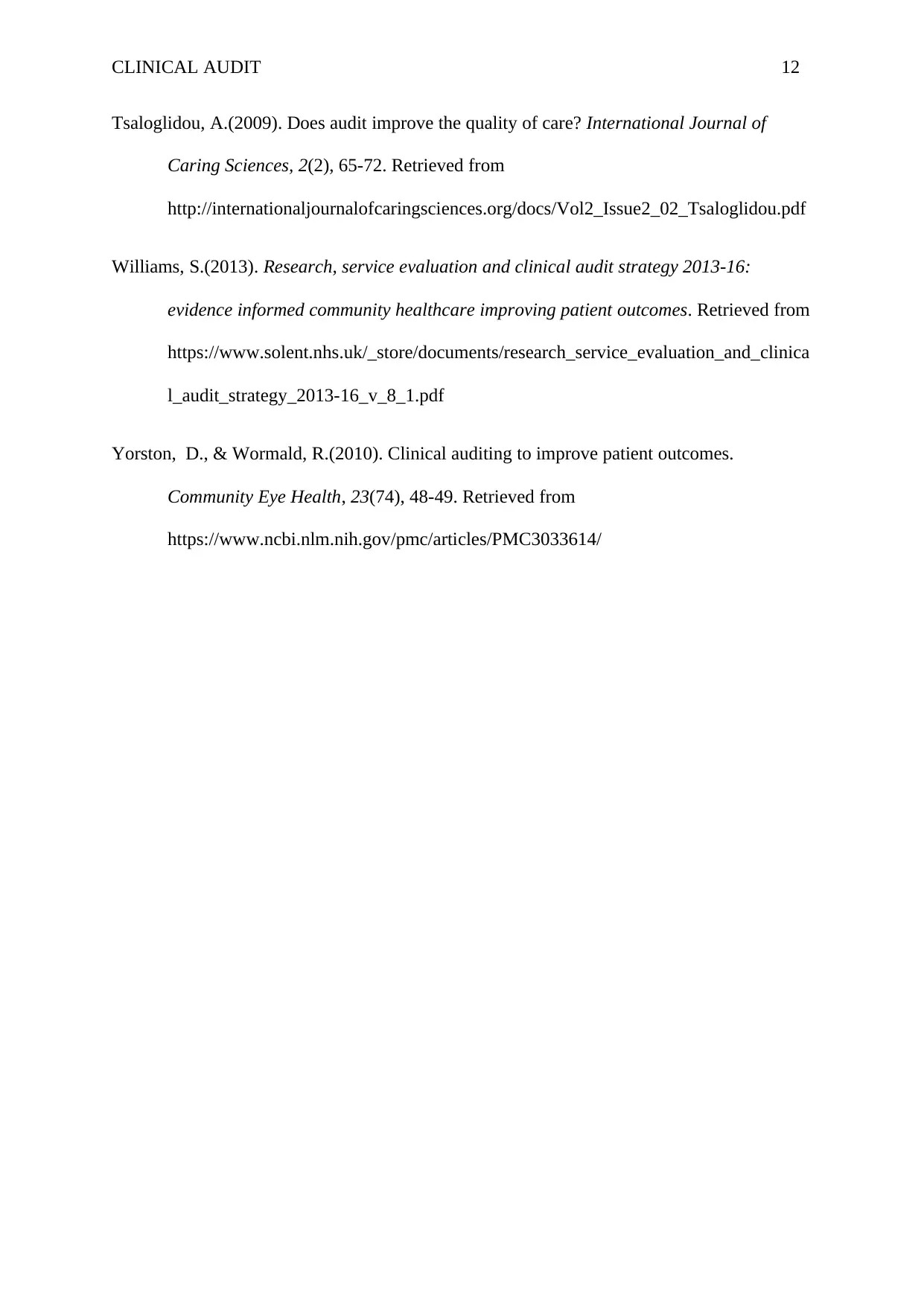
CLINICAL AUDIT 12
Tsaloglidou, A.(2009). Does audit improve the quality of care? International Journal of
Caring Sciences, 2(2), 65-72. Retrieved from
http://internationaljournalofcaringsciences.org/docs/Vol2_Issue2_02_Tsaloglidou.pdf
Williams, S.(2013). Research, service evaluation and clinical audit strategy 2013-16:
evidence informed community healthcare improving patient outcomes. Retrieved from
https://www.solent.nhs.uk/_store/documents/research_service_evaluation_and_clinica
l_audit_strategy_2013-16_v_8_1.pdf
Yorston, D., & Wormald, R.(2010). Clinical auditing to improve patient outcomes.
Community Eye Health, 23(74), 48-49. Retrieved from
https://www.ncbi.nlm.nih.gov/pmc/articles/PMC3033614/
Tsaloglidou, A.(2009). Does audit improve the quality of care? International Journal of
Caring Sciences, 2(2), 65-72. Retrieved from
http://internationaljournalofcaringsciences.org/docs/Vol2_Issue2_02_Tsaloglidou.pdf
Williams, S.(2013). Research, service evaluation and clinical audit strategy 2013-16:
evidence informed community healthcare improving patient outcomes. Retrieved from
https://www.solent.nhs.uk/_store/documents/research_service_evaluation_and_clinica
l_audit_strategy_2013-16_v_8_1.pdf
Yorston, D., & Wormald, R.(2010). Clinical auditing to improve patient outcomes.
Community Eye Health, 23(74), 48-49. Retrieved from
https://www.ncbi.nlm.nih.gov/pmc/articles/PMC3033614/
⊘ This is a preview!⊘
Do you want full access?
Subscribe today to unlock all pages.

Trusted by 1+ million students worldwide
1 out of 12
Related Documents
Your All-in-One AI-Powered Toolkit for Academic Success.
+13062052269
info@desklib.com
Available 24*7 on WhatsApp / Email
![[object Object]](/_next/static/media/star-bottom.7253800d.svg)
Unlock your academic potential
Copyright © 2020–2025 A2Z Services. All Rights Reserved. Developed and managed by ZUCOL.





